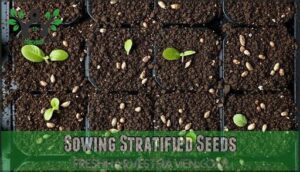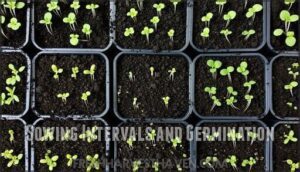This site is supported by our readers. We may earn a commission, at no cost to you, if you purchase through links.
 Growing blueberries from seed takes patience, but you’ll feel the pride when those stubborn little seeds finally sprout.
Growing blueberries from seed takes patience, but you’ll feel the pride when those stubborn little seeds finally sprout.
First, you’ll need to mimic winter—pop the cleaned, dried seeds in the fridge for a month.
Use acidic soil (think pine forest floor), keep it moist, and offer bright light.
With luck and a little discipline, seedlings emerge in several weeks, like shy guests at a party.
Hold off on transplanting until they’ve grown strong, and remember, growing blueberries from seed isn’t a shortcut to fruit, but each step gets you closer to that sweet first harvest.
There’s an art to it—stay tuned.
Table Of Contents
- Key Takeaways
- Blueberry Seed Preparation
- Planting Blueberry Seeds
- Blueberry Seedling Care
- Growing Blueberry Plants
- Blueberry Harvest and Maintenance
- Frequently Asked Questions (FAQs)
- Why can’t wild blueberries be grown from seed?
- Why are blueberries hard to grow?
- How long do blueberries take to grow from seed?
- Can you plant blueberries from store-bought blueberries?
- How long does it take to grow blueberries from seed?
- Can I grow a blueberry bush from a blueberry?
- Can you grow blueberries from seeds?
- How to grow blueberries in the ground?
- How do you get blueberry seeds?
- How do you grow blueberries from store-bought fruit?
- Conclusion
Key Takeaways
- You’ll need patience—blueberries from seed take time, but with the right prep, you’ll see results.
- Make sure to clean, dry, and cold-stratify seeds for 60–90 days to break dormancy and boost germination.
- Use acidic soil, keep it consistently moist, and provide plenty of sunlight for healthy seedlings and strong growth.
- Harvesting berries will take a couple of years, but following proper care and maintenance pays off with sweet, homegrown fruit.
Blueberry Seed Preparation
You’ll need to prepare blueberry seeds carefully, following specific steps like cleaning, drying, and cold stratification to boost your chances of germination.
Think of it as giving each tiny seed a wake-up call—if only your alarm clock worked this well!
Every blueberry seed deserves a wake-up call—springing to life faster than you ever manage on a Monday morning!
Scarification and Stratification
One trick to boosting your blueberry seed germination rates is a two-step tango: seed scarification and cold treatment.
Gently scratch the hard seed coat—a little sanding is like a wake-up call—then move on to stratification methods.
This cold stratification helps with dormancy breakage. Just remember, if you skip either step, your seeds may just hit the snooze button.
Cold Stratification Requirements
Cold stratification is your behind-the-scenes trick for waking blueberry seeds up from deep seed dormancy.
To master this cold treatment, here’s what you need:
- Chill seeds 60–90 days at 34–41°F.
- Keep them slightly moist, never soggy.
- Use reliable stratification methods.
- Avoid temperature swings.
- Promptly plant after freezing periods.
Watch your germination rates soar by following these steps to ensure the best results for cold stratification.
Seed Cleaning and Drying
Before you dream of plump berries, focus on seed cleaning and drying. After seed extraction, rinse seeds to remove pulp, using proven cleaning techniques. Indulge in some “seed purification” for top germination.
Guarantee thorough drying—spread seeds on a paper towel, guaranteeing solid moisture control. For perfect seed prep, remember: clean, dry, and store with care!
Proper handling and storage of seeds and fruits require understanding of fruit preservation methods.
| Step | Purpose | Pro Tip |
|---|---|---|
| Seed Extraction | Remove pulp | Gently mash fruit |
| Rinsing | Seed purification | Use a fine sieve |
| Drying | Moisture control | Air-dry on paper towel |
| Final Clean | Remove debris | Pick out remaining bits |
| Storage | Seed storage | Keep in labeled, dry container |
Stratification Methods
Now that your seeds are clean and dry, it’s time to overcome seed dormancy.
For successful germination rates, try these cold stratification methods:
- Mix seeds with moist storage medium like peat moss for refrigerator seed stratification.
- Use a damp paper towel in a baggie—classic seed starting trick.
- Go with freezing methods, mimicking harsh winter chill.
Planting Blueberry Seeds
Now you’re ready to plant your stratified blueberry seeds in damp peat moss, making sure they’re evenly spaced and lightly covered.
Stick with consistent moisture and a warm, sunny spot—blueberry seeds have been known to take their sweet time germinating, so patience is as important as your watering can.
Sowing Stratified Seeds
After all that cold stratification work, you’re finally ready for the fun part—sowing seeds!
Use a seed starting tray filled with damp, fine sphagnum peat moss.
Evenly distribute the stratified seeds on the surface, cover lightly, and keep your fingers crossed for solid seed germination.
Sowing techniques matter, so don’t rush—proper soil preparation boosts seed viability from the start.
For ideal results, consider using a seed starting system to improve germination rates.
Maintaining Moisture and Temperature
Once your stratified seeds hit the soil, think of water like a gentle piano—steady, not flooding.
Maintain consistent soil moisture, never soggy.
Temperature control plays its own tune: aim for 60-70°F, sidestepping frosty nights with a cloche or plastic cover.
Good water management and keeping humidity levels stable set the roots for strong, healthy germination.
Soil and Lighting Conditions
Keep your blueberry seeds happy by giving them rich, well-draining soil with a soil pH between 4.5 and 5.5.
Blueberries thrive when you meet their lighting needs—at least six hours of sunlight daily is best.
Moisture levels matter too; keep the soil evenly moist but never soggy.
Remember, treating blueberries like sunbathers yields sweet rewards! To optimize growth, understanding soil preparation techniques is essential for a healthy fruit garden.
Sowing Intervals and Germination
When diving into growing blueberries from seed, don’t rush—stagger your sowing intervals for better success.
Seed Timing is key: aim for a moist, warm environment and maintain soil temperatures near 70°F in your seed trays.
Sphagnum peat moss works wonders for the germination process. Use proper Sowing Depths and Moisture Levels to help those Germination Rates climb.
Blueberry Seedling Care
Once your blueberry seeds sprout, you’ll need to step up your care game with consistent moisture, acidic soil, and a watchful eye for pests.
Blueberry seedlings thrive on patience, a splash of moisture, and a dash of vigilance against unexpected garden intruders.
Don’t worry if your seedlings grow slowly at first—blueberries like to take their sweet time before putting down roots.
Transplanting Seedlings
Once your blueberry seedlings show strong root development and a couple of true leaves, it’s time to think about transplanting.
Gently move them into a fresh potting mix, taking care not to disturb their roots.
Remember, patience is your best friend—Seedling Hardening is key.
Gradually acclimate seedlings to outdoor conditions, monitoring soil acidity and moisture for ideal seedling care and growth.
Soil and Fertilization Requirements
Picture your seedlings sipping coffee in acidic soil, soil pH humming between 4.5 and 5.5, and living their best lives.
To master this:
- Amend with organic matter for rich, well-draining soil.
- Choose ammonium-based fertilizer types, not lime.
- Split fertilizer application into small doses for nutrient balance.
Using the right Acidic Soil Mix is essential for healthy growth.
Keep your seedlings happy and on track!
Watering and Mulching Techniques
Consistency matters—think of watering as the heartbeat for seedling success.
Aim for even soil moisture using drip irrigation if you want to feel like a pro.
Lay organic mulch to lock in moisture, stabilize soil, and boost acidity.
Experiment with acid-loving mulch types for best results.
Set a steady water schedule, and avoid dry spells.
The key to maintaining consistent moisture is to understand the importance of mulch and its effects on soil.
| Water Schedules | Mulch Types | Tips for Consistent Moisture |
|---|---|---|
| Weekly | Pine needles | Drip irrigation excels |
| Every 3 days | Oak leaves | Mulch traps soil moisture |
| Drought periods | Bark mulch | Test soil with your finger |
| Morning | Coffee grounds | Avoid overhead sprinklers |
| Evening | Peat moss | Reapply mulch yearly |
Pruning and Pest Management
Once your seedlings are mulched and humming along, it’s time to tackle pruning and pest management for healthy growth.
Pruning techniques keep your plants bushy, while smart pest control and disease management guard against setbacks.
Stay on top of:
- Overzealous bugs munching on new growth
- Fungal threats lurking after rain
- Forgetting those key fertilizer applications
Master these, and your blueberries will thank you.
Growing Blueberry Plants
You’ll need to give your blueberry plants the right conditions, including plenty of sunlight, acidic soil, and regular water to help them establish strong roots.
Stay patient, because these plants like to take their sweet time getting settled—think of it as gardening’s version of a long-term relationship that eventually pays off in berries.
Providing Acidic Soil and Sunlight
After your seedlings have settled, focus on getting those Soil pH Levels just right—blueberry soil flourishes between 4.5 and 5.5.
Mix in pine needles or peat for Acidic Mixtures. Aim for rich well-draining soil with good Soil Aeration.
Set your patch in full sun—Sunlight Requirements matter for acid-loving plants. Tweak pH levels and check Moisture Control often.
Watering and Fertilization Schedules
Every successful grower keeps a close eye on soil moisture, aiming for soil that’s moist but never soggy.
Create regular water schedules, about two inches per week, using drip irrigation for ease.
Apply acidic fertilizers at half the recommended fertilizer rates, spacing fertilizer application tips every 4–6 weeks.
With these exact watering techniques and fertilization methods, your plants will thrive.
Effective irrigation systems, such as drip irrigation systems, play a vital role in maintaining ideal soil conditions.
Pruning and Training Methods
Mastering Pruning Techniques starts with removing weak, damaged, or crossing branches to open the canopy.
Training Systems like shaping bushes for airflow help reduce disease risk and let sunlight work its magic.
Thin fruit clusters for bigger, tastier berries—a classic case of quality over quantity.
Smart bush shaping and pruning keep plant growth healthy, boost yields, and make blueberry care a breeze.
Pruning during dormancy helps promote vigorous growth in the spring.
Optimal pruning timing is late winter, for more information visit Optimal pruning timing.
Managing Pests and Diseases
Blueberry gardens attract more drama than a reality show—thanks to pests and plant diseases.
Stay ahead with this toolkit:
- Scout for common blueberry pests weekly and pick off invaders.
- Practice Fungal Disease Control by pruning for airflow.
- Opt for pest-resistant varieties for blueberry disease resistance.
- Lean on Organic Pest Solutions for pest prevention and strong disease prevention—keep berries thriving!
Blueberry Harvest and Maintenance
Once your blueberry plants start producing, you’ll find that picking berries at the right time and caring for the bushes is just as rewarding as the first sprout.
You might be tempted to taste-test every few days, but a little patience and the right maintenance tips will keep your harvest coming year after year.
Harvesting Ripe Blueberries
Once your plants are thriving, keep an eye out for berry ripeness signs—firm, matte-blue skins and easy detachment are your green light.
Use gentle harvesting techniques, rolling each berry off the stem. For yield optimization, harvest every few days.
Optimal soil pH is also key to sweetness.
Post-harvest handling is easy: avoid squeezing, and send your blueberries straight to refrigeration. A well-timed blueberry harvest means tastier, fresher fruit.
Storing and Freezing Blueberries
Once your blueberry harvest is in, skip washing until you’re ready to use them—moisture invites mold.
Store fresh berries in breathable containers in the fridge, where they’ll keep for two weeks.
For long-term storage, try freezing methods: spread blueberries on a tray, transfer to airtight bags, and freeze. Thaw gently in the fridge—perfect for smoothies, baking, or spontaneous recipe ideas.
Long-Term Plant Care and Pruning
Anyone tending blueberries for years knows longterm plant care is a journey, not a sprint.
Keep your patch thriving and boost fruit yield by following these steps:
- Prune old canes for better light.
- Remove diseased or weak growth for disease control.
- Rejuvenate soil surfaces each spring.
- Feed with acidic mulch.
- Monitor plant health regularly—don’t let surprises blossom!
Soil Maintenance and Acidification
Mossy secrets lie beneath every blueberry bush—maintain soil pH levels between 4.5 and 5.5 by mixing in organic amendments like pine needles and oak leaves.
Acidic fertilizers and strategic watering practices keep organic soils thriving. Prime mulch benefits come from peat moss and coffee grounds; just remember, even expert gardeners sometimes spill the coffee grounds!
| Soil pH Levels | Organic Amendments | Mulch Benefits |
|---|---|---|
| 4.5–5.5 target | Pine needles, peat | Moisture retention |
| Test yearly | Oak leaves, coffee | Weed suppression |
| Adjust as needed | Maintain acidity | Root insulation |
Frequently Asked Questions (FAQs)
Why can’t wild blueberries be grown from seed?
You’ll hit a wall trying to grow wild types because their seeds need cold stratification and precise moist conditions to sprout.
Skip the shortcuts; nature’s got a tough-guy attitude, making patience and know-how non-negotiable.
Why are blueberries hard to grow?
You’ll face an uphill battle because they crave acidic soil, constant moisture, and full sun.
If your garden’s not prepped just right, these picky plants will sulk or stall, making success feel like finding a needle in a haystack.
How long do blueberries take to grow from seed?
Blueberry beginnings bring a bounty of patience—germination and early growth may take months, and you’ll see those sweet blue berries in two to three years.
It’s slow-going, but each sprout is a promise for future snacking.
Can you plant blueberries from store-bought blueberries?
You can plant seeds from store-bought blueberries, but don’t expect instant magic—first, freeze the berries for about three months.
This cold nap breaks dormancy so those tiny seeds are ready to grow into future shrubs.
How long does it take to grow blueberries from seed?
Expect a bit of a long haul—growing these delicious berries from seed takes about two to three years until your harvest bowls start to fill.
Patience pays off; the best berries are worth waiting for!
Can I grow a blueberry bush from a blueberry?
You can grow a bush from a single blueberry, but you’ll need patience.
Extract the seeds, clean and cold-stratify them, then sow in acidic soil.
It’s a slow process, but worth the wait!
Can you grow blueberries from seeds?
It’s like launching a lunar mission, but yes, you can sprout new bushes from seeds.
Scarify, cold-stratify for 90 days, then plant in acidic, moist soil.
It’s slow, but you’ll earn bragging rights with every berry.
How to grow blueberries in the ground?
Pick a sunny spot with acidic, well-draining soil.
Dig a wide hole, mix in peat moss, set your blueberry, and backfill.
Water deeply, mulch thickly, and keep soil moist.
Prune for shape—don’t let the roots wander.
How do you get blueberry seeds?
For blueberry seeds, scoop out the pulp from ripe berries, mash it up, then rinse with water to separate seeds.
Dry and clean them well.
If patience were a sport, waiting for these little guys to sprout would win gold.
How do you grow blueberries from store-bought fruit?
Crack open that store-bought fruit, scoop out the seeds, and wash off the pulp.
Let them chill with moist paper towels in your fridge for three months, then plant in acidic soil.
Keep things moist—patience pays off!
Conclusion
Imagine peering into your planter, wondering if today’s the day sprouts appear—growing blueberries from seed is a true test of patience and skill.
You’ve set the stage: acidic soil, steady moisture, bright light, and careful timing.
Soon, those tiny seedlings will reward your discipline with growth, setting you firmly on the path toward your first homegrown fruit.
Stick to these scientific yet practical steps, and you’ll master the art—and science—of growing blueberries from seed.













